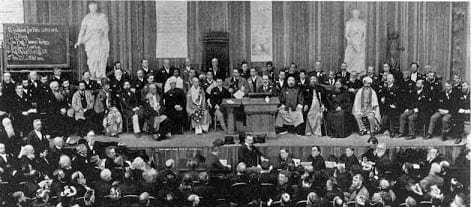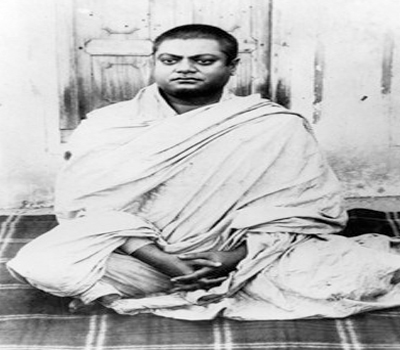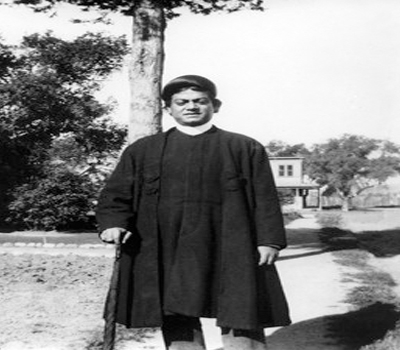Fire a mass of bird-shot; one at least will strike; give a man a whole museum of truths, he will at once take what is suited to him. Past lives have moulded our tendencies; give to the taught in accordance with his tendency. Intellectual, mystical, devotional, practical—make one the basis, but teach the others with it. Intellect must be balanced with love, the mystical nature with reason, while practice must form part of every method. Take everyone where he stands and push him forward (7.98)
‘A Voice without a Form’
Through the Lord’s will, the desire for name and fame has not yet crept into my heart, and I dare say never will. I am an instrument, and He is the operator. Through this instrument He is rousing the religious instinct in thousands of hearts in this far-off country. Thousands of men and women here love and revere me. … ‘He makes the dumb eloquent and the lame cross mountains.’ I am amazed at His grace. Which-ever town I visit, it is in an uproar. They have named me ‘the cyclonic Hindu’. Remember, it is His will—I am a voice without a form (6.283).
Swamiji started preaching the message of Vedanta in the West, and we received reports of his lectures here. At first we could hardly believe that these were lectures by Swamiji when we read them. He didn’t use the language or the ideas we were familiar with. Everything became changed. He had a new message and a new language. Before going to America, in his conversations here, he had a leaning towards the path of knowledge, and his language was quite philosophical and scholarly. But in the lectures he gave in the West his language was simple and direct and his ideas were full of life and love. Returning to India, he remarked: ‘Do you think I gave those lectures? It was the Master who spoke through me.’
Were those who heard Vivekananda speaking from the platform able to detect that it was the Lord speaking through him? May Elizabeth Stevenson—Sister Avabamia or Avavamia—heard Vivekananda speak, possibly in San Francisco in 1900. She was later initiated by Swami Abhedananda and beginning in 1908 lectured on Vedanta and opened Vedanta study centres in Australia and New Zealand. She wrote of her own experience of hearing Vivekananda: ‘No matter how long he spoke, he was fresh aft er two hours of speaking as he was at the commencement of his lecture. To lose sight of the self and let God have the vocality at His merciful disposal is another secret which none knows but he who has the experience and has been taught by the Lord Himself. ’
The Voice behind the Voice Vivekananda
once explained to Priyanath Sinha:
Taking His name, if you set yourself to work, He will accomplish everything Himself through you. … That power may come to all. That power comes to him who observes unbroken Brahmacharya for a period of twelve years, with the sole object of realising God. I have practised that kind of Brahmacharya myself, and so a screen has been removed, as it were, from my brain. For that reason, I need not any more think over or prepare myself for any lectures on such a subtle subject as philosophy. Suppose I have to lecture tomorrow; all that I shall speak about will pass tonight before my eyes like so many pictures; and the next day I put into words during my lecture all those things that I saw.
In The Gospel of Sri Ramakrishna, the Master declared his identity: ‘The other day I saw Satchidananda come out of this sheath (his body). It said, “I incarnate Myself in every age”.’ On another occasion Sri Ramakrishna said to M, ‘If you ever see me instructing you, then know that it is Satchidananda Himself that does so.’ Sri Ramakrishna’s ego had died forever. It was God Himself who worked and spoke through him. Thus we come to this conclusion—that Vivekananda’s voice, Sri Ramakrishna’s voice, and the voice of Brahman are one and the same. As Brahman is eternal and immortal, so is the voice, the message, of a knower of Brahman.
In 1901 when Vivekananda was in Shillong and quite ill, he had a terrible attack of asthma and could not breathe. Pressing two pillows against his chest, he said: ‘What does it matter! I have given them enough for fifteen hundred years.’ In Swami Chetanananda’s interpretation of this incident, Vivekananda meant that his words, his message, would continue working in the minds of people for fifteen hundred years, after his form had disappeared. Before he passed away in 1902, Vivekananda made a similar prophetic remark: ‘The spiritual impact that has come here to Belur will last fifteen hundred years—and this will be a great university. Do not think I imagine it. I see it.’ The point I want to emphasize is that it is really Ramakrishna—his life, his experiences, his teachings—that has come to the West through Vivekananda and has taken roots that will deepen and spread in the coming decades. Vivekananda remarked that Ramakrishna was ‘a man whose whole life was a Parliament of Religions’, and the best commentary on the Upanishads. And Ramakrishna himself stated: ‘The spiritual experiences of this place (meaning himself ) have surpassed even the Vedas and Vedanta.’
And Vivekananda described that Vedanta and Ramakrishna taught this way:
All religions have for their object the teaching either of devotion, knowledge, or Yoga, in a concrete form. Now, the philosophy of Vedanta is the abstract science which embraces all these methods, and this it is that I teach, leaving each one to apply it to his own concrete form. I refer each individual to his own experiences, and where reference is made to books, the latter are procurable, and may be studied by each one for himself. Above all, I teach no authority proceeding from hidden beings speaking through visible agents, any more than I claim learning from hidden books or manuscripts. … Truth stands on its own authority, and truth can bear the light of day. …
I propound a philosophy which can serve as a basis to every possible religious system in the world, and my attitude towards all of them is one of extreme sympathy—my teaching is antagonistic to none. I direct my attention to the individual, to make him strong, to teach him that he himself is divine, and I call upon men to make themselves conscious of this divinity within. Th at is really the ideal—conscious or unconscious—of every religion.
Never before Swamiji’s time had the term [Vedanta] been given such universal significance as he gave it. Never before had it been broadened into a philosophy and religion which included every faith of the world and every noble effort of man—reconciling spirituality and material advancement, faith and reason, science and mysticism, work and contemplation, service to man and absorption in God. Never before had it been conceived as the one universal religion, by accepting the principles of which the follower of any or no creed could continue along his own path and at the same time be able to identify himself with every other creed and aspect of religion.
The voice spoke only on a special and limited but very important fi eld of spiritual experience and it ceased as soon as it had finished saying all that it had to say on that subject. … It was the spirit of Vivekananda which first gave me a clue in the direction of the supermind. This clue led me to see how Truth-Consciousness works in everything. … Vivekananda came and gave me the knowledge of the intuitive mentality. I had not the least idea about it at that time. He too did not have it when he was in the body. He gave me detailed knowledge illustrating each point. The contact lasted about three weeks and then he withdrew.
I can see that the era of the world workers is quickly passing away, but I do think we ought to have a nucleus in Europe, before the movement of Ramakrishna settles down to the silent thought germination which must come. … You see, when we who understood Swamiji, and remember Him are dead, there will come a long period of obscurity and silence, for the work that He did. It will seem to be forgotten, until, suddenly, in 150 or 200 years, it will be found to have transformed the West.
There are eyes that can see at a distance of four-teen thousand miles. It is quite true. Keep quiet now, everything will see the light in time, as far as He wills it. Not one word of His proves untrue. My brother, do men grieve over the fight of cats and dogs? So the jealousy, envy, and elbowing of common men should make no impression on your mind. For the last six months I have been saying the curtain is going up, the sun is rising. Yes, the curtain is lifting, by degrees, slow but sure; you will come to know it in time. He knows. One cannot speak out one’s mind. These are things not for writing. … Never let go your hold of the rudder, grasp it firm. We are steering all right, no mistaking that, but landing on the other shore is only a question of time. Th at’s all. Can a leader be made, my brother? A leader is born. And it is a very difficult task to take on the role of a leader. One must be dasasya dasah — a servant of servants, and must accommodate a thousand minds. Th ere must not be a shade of jealousy or selfishness, then you are a leader. First, by birth, and secondly, unselfish—that’s a leader. Everything is going all right, everything will come round. He casts the net all right, and winds it up likewise. … Ours is but to follow; love is the best instrument. Love conquers in the long run. It won’t do to become impatient—wait, wait—patience is bound to give success.
Stirring up Minds
Shankara’s Non-dualistic explanation of Vedanta is true, and so is the Qualified Non-dualistic interpretation of Ramanuja.
Narendra: ‘What is Qualified Non-dualism?’
Master: ‘It is the theory of Ramanuja. According to this theory, Brahman, or the Absolute, is qualified by the universe and its living beings. These three—Brahman, the world, and living beings—together constitute One. Take the instance of the bel-fruit. … At first it appears that the real thing in the fruit is the flesh, and not its seeds or shell. Then by reasoning you find that the shell, seeds, and flesh all belong to the fruit; the shell and seeds belong to the same thing that the flesh belongs to. Likewise, in spiritual discrimination one must first reason, following the method of ‘Not this, not this’: God is not the universe; God is not the living beings; Brahman alone is real and all else is unreal. Then one realizes, as with the bel-fruit, that the Reality from which we derive the notion of Brahman is the very Reality that evolves the idea of living beings and the universe. The Nitya and the Lila are the two aspects of one and the same Reality; therefore, according to Ramanuja, Brahman is qualified by the universe and the living beings.’
I said that this question of Narendra gives me a jolt. Why? Because it is 11 March 1885, and in less than eighteen months this young man will be the leader of a band of monastic brothers. Already he often leads the others in vigorous discussions on various spiritual topics involving philosophical ideas. The Master even sets up some of these verbal duals, and usually Narendra tears the other Vedanta. person’s arguments to shreds. His question shocks
Narendra and the other monastic brothers areliving at the monastery. Haramohan and Mhave arrived. Shashi is busy with the Master’s worship service. Narendra is about to go to the Ganges for his bath.
Narendra: ‘Krishna mainly discussed japa andausterity in the Gita.’M: ‘How is that? Then why did he give so much advice to Arjuna?’Narendra: ‘Krishna did not ask Arjuna to perform family duties.’M: ‘When Krishna asked Arjuna to fight, Arjuna was a householder. He, therefore, was advising Arjuna to perform his family duties in a detached way.’A little later:Baburam: ‘I don’t understand the Gita and other scriptures. The Master said the right thing, “Renounce, renounce”.’Shashi: ‘Do you know what the real import of the word “renounce” is? It means to remain in the world as an instrument in the hands of God’ .(212)
Vivekananda always stressed strength, fearlessness, and stupendous willpower. In his talks on the Gita at the Alambazar Math, he also declared: ‘If one reads this one Shloka … one gets all the merits of reading the entire Gita; for in this one Shloka lies imbedded the whole Message of the Gita’ (4.110): ‘Yield not to unmanliness, O son of Pritha! Ill doth it become thee. Cast off this mean faint-heartedness and arise, O scorcher of thine enemies’ (4.108). And in May 1900 in San Francisco, he told his students: ‘You may be the greatest philosopher but as long as you have the idea that you are the body, you are no better than the little worm crawling under your foot!’ This was Vivekananda, the world teacher. As he grew in spiritual power, so his penchant for mind-bending declarations grew in intensity. His closing message to those Gita students was: ‘“Be brave! Be strong! Be fearless! Once you have taken up the spiritual life, fi ght as long as there is any life in you. … Don’t die with fright, Die fighting. Don’t go down till you are knocked down.” Then with his right arm extended, he thundered, “Die game! Die game! Die Game!”’ (6.218).
Later that same day, 17 February 1887, at Baranagore, the swami made another provocative remark that brought immediate sharp reactions from Rakhal and Mani. In this exchange perhaps the swami was trying to gauge the spiritual progress of other devotees. It also resulted in a reminder of Ramakrishna’s own words on a crucial point in spiritual discipline:
Narendra: ‘The vision of God is a kind of false perception.’
Rakhal: ‘What do you mean? You have experienced it.’Narendra ( with a smile): ‘One gets such a vision because of a derangement of the brain, like a hallucination.’Mani: ‘Brother, whatever you may say, the Master had visions of divine forms; so how can you say that it is a derangement of the brain? Do you remember when Shivanath remarked that the Master’s samadhi was a kind of nervous disorder or mental illness, and the Master replied, “Does anyone become unconscious thinking of Consciousness? ” ’
Swamiji’s Impact on the US
It is important to remember that Vivekananda was a great conciliator too. In a letter to Alasinga Perumal in 1894 he said: ‘Be always ready to concede to the opinions of your brethren, and try always to conciliate.’ Another incident shows how he himself did this. One day there was a discussion at Belur Math on the idea of inauspicious stars—like magha and ashlesha—and times of the week, like the late hours of Thursday. Swami Shuddhananda said:
Shashi Maharaj implicitly believed and followed those ideas. But some of us did not care for them, considering them to be mere superstition. As a result, two groups formed in the monastery. Th ose who believed in inauspicious stars and times said: ‘People who do not believe these things do not believe in Sri Ramakrishna, because the Master followed these customs.’ Soon the issue of both parties reached Swamiji.Then he said: ‘Yes, there is an effect of those customs, but the power of the Atman is infinite. The Atman’s power can overcome those evil effects. Increase the power of the Atman, then none of those things will affect you.’






Leave A Comment
You must be logged in to post a comment.